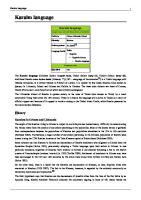Crimean Tatar Language [PDF]
Crimean Tatar language From Wikipedia, the free encyclopedia Not to be confused with Tatar language. Exclamation mark wi
31 1 25KB
Papiere empfehlen
![Crimean Tatar Language [PDF]](https://vdoc.tips/img/200x200/crimean-tatar-language.jpg)
- Author / Uploaded
- Glados
Datei wird geladen, bitte warten...
Zitiervorschau
Crimean Tatar language From Wikipedia, the free encyclopedia Not to be confused with Tatar language. Exclamation mark with arrows pointing at each other This article or section appears to contradict itself on Are they mutually intelligible or not The leads of these two articles contradict one another. Please see the talk page for more information. (June 2017) Crimean Tatar Qirimtatarca, Qirimtatar tili ??????????????, ??????????? ???? alternative version ????????????, ?????????? ???? Pronunciation [q?r?mt?t?r'd???] Native to Ukraine, Turkey, Uzbekistan, Romania, Russia, Kyrgyzstan, Bulgaria Region Black Sea Ethnicity Crimean Tatars Native speakers 480,000 (2006�2011)[1] Language family Turkic Common Turkic Kipchak Kipchak�CumanOghuz Crimean Tatar Writing system Cyrillic and Latin; previously Arabic (Crimean Tatar alphabet) Official status Official language in Russia Republic of Crimea[2] Recognised minority language in Ukraine[3] Autonomous Republic of Crimea[2] Romania[4] Language codes ISO 639-2 crh ISO 639-3 crh Glottolog crim1257[5] Linguasphere part of 44-AAB-a Crymean Tatar lang.png Crimean Tatar-speaking world This article contains IPA phonetic symbols. Without proper rendering support, you may see question marks, boxes, or other symbols instead of Unicode characters. For an introductory guide on IPA symbols, see HelpIPA. Part of a series on Crimean Tatars Tamga symbol of the Crimean Tatar Gerae family By region or country Bulgaria Romania Turkey United States Uzbekistan Religion Sunni Islam (Hanafi) Languages and dialects Crimean Tatar History Khanate (1441�1783) Taurida Oblast (1783�1796) Taurida Governorate (1802�1917) People's Republic (1917�1918)
Crimean ASSR (1921�1945) S�rg�n (1944) Crimean Oblast (1945�1991) Autonomous Republic (1991�2014) Republic of Crimea (2014�2016) People and groups List Biographies Khans Mejlis Milliy Firqa v t e Welcome to Crimea (Qirimga hos keldi�iz!) written in Crimean Tatar Cyrillic, airport bus, Simferopol International Airport Crimean Tatar Latin script on a plate in Bakhchisaray An example of Crimean Tatar Arabic script Crimean Tatar (?????????????? Qirimtatarca, ??????????? ???? Qirimtatar tili), also called Crimean Turkish[1] or simply Crimean,[1] is a Kipchak Turkic language spoken in Crimea and the Crimean Tatar diasporas of Uzbekistan, Turkey, Romania and Bulgaria, as well as small communities in the United States and Canada. It should not be confused with Tatar proper, spoken in Tatarstan and adjacent regions in Russia; the languages are related but not mutually intelligible. Crimean Tatar arrived in the 13th century with the Mongol Golden Horde, succeeding the Crimean Greek and Crimean Gothic Principality of Theodoro, and continued through the 15th�18th century Crimean Khanate period. Though only distantly related, it has been extensively influenced by nearby Oghuz Turkic languages such as Turkish, Turkmen and Azerbaijani. Contents [hide] 1 Number of speakers 2 Dialects 3 History 4 Phonology 4.1 Vowels 4.2 Consonants 5 Current situation 6 Writing systems 6.1 Arabic alphabet 6.2 Latin alphabet 6.3 Cyrillic alphabet 7 Comparison with other languages 7.1 Turkish and Azerbaijani 7.2 Tatar proper 8 Notes 9 References 10 Bibliography 11 External links Number of speakers[edit] Today, more than 260,000 Crimean Tatars live in Crimea. Approximately 150,000 reside in Central Asia (mainly in Uzbekistan), where their ancestors had been exiled in 1944 during World War II by the Soviet Union. However, of all these people, mostly the older generations are the only ones still speaking Crimean Tatar.[6] In 2013, the language was estimated to be on the brink of extinction, being taught in only around 15 schools in Crimea. Turkey has provided support to Ukraine, to aid in bringing the schools teaching in Crimean Tatar to a modern state.[7] An estimated 5 million people of Crimean origin live in Turkey, descendants of those who emigrated in the 19th and early 20th centuries.[citation needed] Of these an estimated 2,000 still speak the language.[6] Smaller Crimean Tatar communities are also found in Romania (22,000), Bulgaria (6,000), and the United States.[6] Crimean Tatar is one of the seriously endangered languages in
Europe.[8] Almost all Crimean Tatars are bilingual or multilingual, using as their first language the dominant languages of their respective home countries, such as Russian, Turkish, Uzbek, or Ukrainian. Dialects[edit] Each of the three subethnic groups of the Crimean Tatars has its own dialect. The dialect of the Nogays, the former inhabitants of the Crimean steppe (should not be confused with Nogai people), is of Kypchak�Nogay origin. The Yaliboylus, who lived on the southern coast of Crimea before 1944, speak an Oghuz dialect. The Tat Tatars from the Crimean Mountains (should not be confused with Tat people) use a middle dialect of Kypchak�Cuman origin. The dialect is a direct descendant of the Cuman language, but it has been strongly influenced by Oghuz.[citation needed] The modern Crimean Tatar written language is based on Tat because the Tats comprise about 55% of the total Crimean Tatar population. History[edit] The forming of the Crimean Tatar spoken dialects began with the first Turkic invasions of Crimea and ended during the period of the Crimean Khanate. However, the official written languages of the Crimean Khanate were Chagatai and Ottoman Turkish. After Islamization, Crimean Tatars wrote with an Arabic script. In 1876, the different Turkic Crimean dialects were made into a uniform written language by Ismail Gasprinski. A preference was given to the Oghuz dialect of the Yaliboylus, in order to not break the link between the Crimeans and the Turks of the Ottoman Empire. In 1928, the language was reoriented to the middle dialect spoken by the majority of the people. In 1928, the alphabet was replaced with the Uniform Turkic Alphabet based on the Latin script. The Uniform Turkic Alphabet was replaced in 1938 by a Cyrillic alphabet. Since the 1990s, the government has encouraged replacing the script with a Latin version again, but the Cyrillic is still widely used (mainly in published literature and newspapers). The current Latin-based Crimean Tatar alphabet is the same as the









